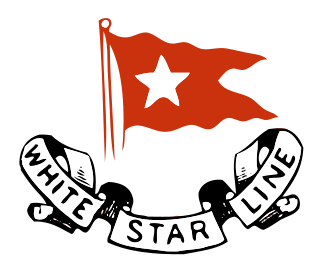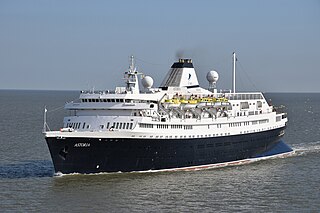
A ship is a large vessel that travels the world's oceans and other navigable waterways, carrying cargo or passengers, or in support of specialized missions, such as defense, research and fishing. Ships are generally distinguished from boats, based on size, shape, load capacity and purpose. Ships have supported exploration, trade, warfare, migration, colonization, and science. Ship transport is responsible for the largest portion of world commerce.

A steamship, often referred to as a steamer, is a type of steam-powered vessel, typically ocean-faring and seaworthy, that is propelled by one or more steam engines that typically move (turn) propellers or paddlewheels. The first steamships came into practical usage during the early 19th century; however, there were exceptions that came before. Steamships usually use the prefix designations of "PS" for paddle steamer or "SS" for screw steamer. As paddle steamers became less common, "SS" is incorrectly assumed by many to stand for "steamship". Ships powered by internal combustion engines use a prefix such as "MV" for motor vessel, so it is not correct to use "SS" for most modern vessels.
Transatlantic crossings are passages of passengers and cargo across the Atlantic Ocean between Europe or Africa and the Americas. The majority of passenger traffic is across the North Atlantic between Western Europe and North America. Centuries after the dwindling of sporadic Viking trade with Markland, a regular and lasting transatlantic trade route was established in 1566 with the Spanish West Indies fleets, following the voyages of Christopher Columbus.

An ocean liner is a type of passenger ship primarily used for transportation across seas or oceans. Ocean liners may also carry cargo or mail, and may sometimes be used for other purposes. The Queen Mary 2 is the only ocean liner still in service to this day.

A passenger ship is a merchant ship whose primary function is to carry passengers on the sea. The category does not include cargo vessels which have accommodations for limited numbers of passengers, such as the ubiquitous twelve-passenger freighters once common on the seas in which the transport of passengers is secondary to the carriage of freight. The type does however include many classes of ships designed to transport substantial numbers of passengers as well as freight. Indeed, until recently virtually all ocean liners were able to transport mail, package freight and express, and other cargo in addition to passenger luggage, and were equipped with cargo holds and derricks, kingposts, or other cargo-handling gear for that purpose. Only in more recent ocean liners and in virtually all cruise ships has this cargo capacity been eliminated.

The White Star Line was a British shipping line. Founded out of the remains of a defunct packet company, it gradually grew to become one of the most prominent shipping companies in the world, providing passenger and cargo services between the British Empire and the United States. While many other shipping lines focused primarily on speed, White Star branded their services by focusing more on providing comfortable passages for both upper class travellers and immigrants.

The Age of Sail is a period in European history that lasted at the latest from the mid-16th to the mid-19th centuries, in which the dominance of sailing ships in global trade and warfare culminated, particularly marked by the introduction of naval artillery, and ultimately reached its highest extent at the advent of steam power. Enabled by the advances of the related age of navigation, it is identified as a distinctive element of the early modern period and the Age of Discovery.

SS John W. Brown is a Liberty ship, one of two still operational and one of three preserved as museum ships. As a Liberty ship, she operated as a merchant ship of the United States Merchant Marine during World War II and later was a vocational high school training ship in New York City for many years. Now preserved, she is a museum ship and cruise ship berthed at Pier 13 in Baltimore Harbor in Maryland.

RMS Aquitania was an ocean liner of the Cunard Line in service from 1914 to 1950. She was designed by Leonard Peskett and built by John Brown & Company in Clydebank, Scotland. She was launched on 21 April 1913 and sailed on her maiden voyage from Liverpool to New York on 30 May 1914. She was given the title of Royal Mail Ship (RMS) like many other Cunard ocean liners since she carried the royal mail on many of her voyages. Aquitania was the third in Cunard Line's grand trio of express liners, preceded by RMS Mauretania and RMS Lusitania, and was the last surviving four-funnelled ocean liner. Shortly after Aquitania entered service, the First World War broke out, during which she was first converted into an auxiliary cruiser before being used as a troop transport and a hospital ship, notably as part of the Dardanelles Campaign.

SS Europa, later SS Liberté IMO 5607332, was a German ocean liner built for the Norddeutsche Lloyd line (NDL) to work the transatlantic sea route. Launched in 1928, she and her sister ship, Bremen, were the two most advanced, high-speed steam turbine ocean vessels in their day, with both earning the Blue Riband.

Iron-hulled sailing ships represented the final evolution of sailing ships at the end of the age of sail. They were built to carry bulk cargo for long distances in the nineteenth and early twentieth centuries. They were the largest of merchant sailing ships, with three to five masts and square sails, as well as other sail plans. They carried lumber, guano, grain or ore between continents. Later examples had steel hulls. They are sometimes referred to as "windjammers" or "tall ships". Several survive, variously operating as school ships, museum ships, restaurant ships, and cruise ships.

RMS Britannia was an ocean liner of the British and North American Royal Mail Steam Packet Company, later known as Cunard Steamship Company. She was launched on Wednesday 5 February 1840, at the yard of Robert Duncan & Company in Greenock, Scotland. The ship and her Britannia-class sisters, Acadia, Caledonia, and Columbia, were the first ocean liners built by the company.
The Collins Line was the common name for the American shipping company started by Israel Collins and then built up by his son Edward Knight Collins, formally called the New York and Liverpool United States Mail Steamship Company. Under Edward Collins' guidance, the company grew to be a serious competitor on the transatlantic routes to the British Cunard shipping company.

Deutschland was a blockade-breaking German merchant submarine used during World War I. It was developed with private funds and operated by the North German Lloyd Line. She was the first of seven U-151-class U-boats built and one of only two used as unarmed cargo submarines.

USS Merak (AF-21), the second Navy ship of the name, was the United Fruit Company cargo and passenger liner Veragua that served as a United States Navy Mizar-class stores ship in World War II.

MV Astoria is a ship that was constructed as the transatlantic ocean liner Stockholm for Swedish American Line, and rebuilt as a cruise ship in 1993. Ordered in 1944, and commenced service in 1948, at 76 years old, she is the oldest deep water passenger liner still around in a non retired status. As Stockholm, she was best known for an accidental collision with Andrea Doria in July 1956, resulting in the sinking of the latter ship and 46 fatalities off the coast of Nantucket, Massachusetts, United States.

RMS Empress of Canada was an ocean liner launched in 1960 and completed the following year by Vickers-Armstrongs of Walker, Newcastle upon Tyne, England for Canadian Pacific Steamships Ltd. This ship, the third CP vessel to be named Empress of Canada, regularly traversed the transatlantic route between Liverpool and Canada for the next decade. Although Canadian Pacific Railways was incorporated in Canada, the Atlantic liners were owned and operated by the British registered subsidiary Canadian Pacific Steamships Ltd. and were always British flagged and manned and therefore Empress of Canada was not the flagship of the Canadian Merchant Marine.

The America class was the replacement for the Britannia class, the Cunard Line's initial fleet of wooden paddle steamers. Entering service starting in 1848, these six vessels permitted Cunard to double its schedule to weekly departures from Liverpool, with alternating sailings to New York. The new ships were also designed to meet new competition from the United States.

The wooden sailing ship Oneida was a merchant vessel built for the New York to Le Havre, France packet trade. It was owned by John J. Boyd and Edward Hincken, and it operated on the Havre Second Line.


















